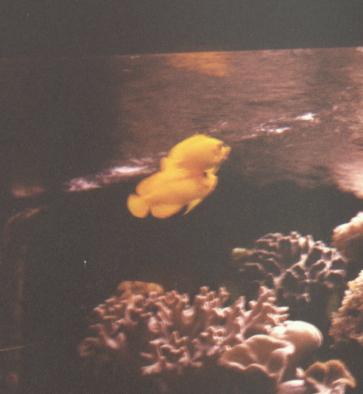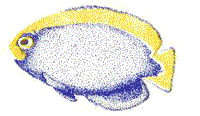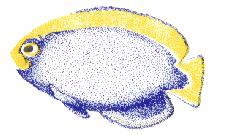|
Reproductive Biology of Pygmy Angelfish,
the genus Centropyge
By J.A. Bauer Jr. and S.E. Bauer
( an excerpt taken from the Bulletin of Marine Science, Vol 31, Issue
3, 1981 )
Spawning Ritual
The spawning behavior of Centropyge was nearly
identical in all species studied and also showed great similarity between
aquarium and reef settings. Spawning occurred at the conclusion of an intricate
courtship which was repeated with great regularity each evening- The following
generalized account summarizes our observations:
Elements of Spawning Ritual
Transitional Activity
In our field studies, as evening approaches with the sun
just above the horizon there is a subtle change from casual roaming and
preoccupation with grazing, to an increasing group awareness and interaction.
Female Station - Each female becomes stationed
near her own coral prominence, the same one each evening, and remains in
or around this shelter, which is located within the group spawning territory.
Male Patrolling - The male begins a methodical
and repetitive patrolling of the spawning territory, precisely retracing
his path on each round at 2-6 minute intervals. Agnostic encounters with
other species within the territory are seen commonly. In our laboratory
studies patrolling was not discernible with in the limited confines of
the aquariurm.
Courtship
Courtship consists of the elaborate rituals of the prespawning
male-female interactions and was identical in the field and aquarium.
Visitation - The patrolling male visits each female
station sequentially on each round, makes a deliberate search for the female
on or inside her coral, and engages in brief courtship gestures which increase
in intensity and duration on each round.
Approach - Meet - Grunt. - As the male approaches
a female station, the female often emerges from her coral shelter, as if
signaled by the approaching male, and swims out to meet him. In the aquarium,
a chirping grunt is audible ( particularly in C. flavissimus ) as the male
approaches the female. Because of the females awareness of the approaching
male a similar signal is suspected during reef approaches.
Circling - As the male approaches a female station
, he excellerates his swimming tempo to an impulsive circling around the
female, as if spinning on a string. His body is curved and there is a full
fan-like erection of unpaired fins, maxirnallv increasing the concave lateral
body surface presented to the female. Later in courtship the female may
also participate and both may engage in head-to-tail circling.
Female Follow - After a brief courtship encounter,
the male continues on his rounds and the female often follows part or rarely
all the way to the next female station or a coral prominence. Simultaneous
courtship play with two or three females may then be seen and an occasional
early spawning attempt with one female may be interrupted by agnostic interference
by another female.
Quiver Display - As. the male repeatedly returns
to a female station, courtship intensifies on each visit. Bursts of circling
by the male are interrupted by sudden stops; paired fins perform a nonpropulsive
flutter, the entire body quivers and blanches and unpaired fins are fully
flared.
Flutter Rise - After several male visits and courtship
encounters, the female eventually indicates willingness to spawn by ascending
over her coral with non-propulsive fin flutter, body quiver and blanching,
and full erection of unpaired fins.
Blanching - The posterolateral body surface brightens
as the color intensity fades. Blanching is more marked in the male during
courtship. Female blanching is greatest during the flutter rise and indicates
her readiness to spawn. Some blanching was noticeable in all species studied;
in uniformly colored fishes, such as the dark blue
C. argi, dark
reddish brown C. fisheri and deep blue C. acanthops, the
body sides blanch to a grayish hue; the deep yellow
C. flavissimus
fades
to near white. The dark blue and red banded
C. bispinosus fades
its blue bars converting the dark blue-red body sides to a pale red; in
the deep red and black banded C. loriculus the red fades to orange
These color changes may vary rapidly and are most noticeable under the
aquarium lights; but even in the reef light the body sides of
C. argi
blanch
visibly.
Spawning
The final interactions culminating in gamete discharge.
Spawning Posture - There is a characteristic alignment
of spawning partners with the male in an oblique (45 degree) head up position,
its snout nuzzled against the posterolateral body side of the female just
dorsad to the genital orifice, at an area overlying the ovary. The female
is horizontal or slightly tilted, head down.
Spawn Rise - Maintaining this configuration, the
spawning pair rises gradually in the water column some 10 30 cm as both
partners display, vigorous fin flutter and body quiver: the pectoral fins
of the female are erected strongly downward. The male appears to push upwards
against the female tilting her slightly head down. Most initial spawning
rises are brief and dissolve gently after a 5 - 15 cm rise as the partners
drift out of alignment. Occasionally a bulging egg mass is seen to protrude
from the female cloaca on each of the last few spawning rises, just before
egg discharge.
Thrust and Turn - Egg discharge is, initiated by
an abrupt forceful thrust by the male snout against the female abdomen
as if attempting to express eggs from the ovary. The male then executes
a split-second reversal of its body axis swinging its head sharply downward
and flinging its curved posterior body up against the side of the female.
This lightning-speed action approximates the genital orifices of the mating
partners for a fleeting instant when sperm discharge results in mixing
of released gametes for fertilization.
Break and Retire - With gamete release the spawning
posture is suddenly disrupted as both partners forcefully dart towards
substrate. T male having swung its head downward during the spawning flip
is usually in the lead and is followed by the female which occasionally
delivers a rapid nip to the male as they dart for shelter. The female hides
in her coral and becomes unresponsive to further male courtship advances;
the male patrols his territory for a short period after all females have
spawned until he retires as darkness prevails.
 
The left photo shows a pair C. flavissimus in the
"Spawning Posture".
The right photo shows a pair of C. resplendens
just prior to "Thrust and Turn".
For more information visit....


Dwarf
Angel, Pygmy Angels, Centropyge
|















